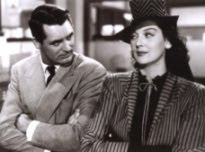

The beleaguered film critics fraternity - and I do mean
fraternity - received something of a respite this week with two major announcments.
Now, two announcements may not seem like much, given the slow, agonizing death of film criticism that we've been witnessing for the past few years. But with 60-some long-time movie critics having been offed by their ungrateful employers to date - a phenomenom documented by
Sean P. Means, of The Salt Lake Tribune, in an on-going column, rather mordantly titled
The Departed - every opportunity helps.
Turner Classic Movies was the first to weigh in with a release drumbeating its special
Critic’s Choice showcase, which will air each Monday and Wednesday night during October, starting Oct. 4 with critic/historian Leonard Maltin, editor of "Leonard Maltin’s Movie Guide," and the Los Angeles Times’ Kenneth Turan. The segments were taped in July.
A total of 16 movie critics will be participating, each introducing two movie picks with TCM's Robert Osborne in tow. Sixteen movie critics - 14 men and two women. I repeat,
fourteen men and two -count 'em - two women.
All white.
So exactly what's wrong with this picture?
I think I just answered my own question. The participants are all fine critics and, frankly, several of them are friends, but where's the diversity that's a unique contemporary feature of the criticism community?
The lone two women involved - Kim Morgan and Susan Granger - are solid picks because they represent distinct opposite ends of the film-reviewing spectrum.
Granger is a pro with years of experience and Morgan is a ubiquitous contributor on
The Hit List, the MSN movies blog, and the author of the compelling, wittily narcissistic blog,
Sunset Gun .
But there are more than two women out there reviewing film today.
Well, ok, off the top of my head, there's Manohla Dargis of The New York Times; Lisa Schwartzbaum of Entertainment Weekly; Amy Taubin of Film Comment and The Village Voice; Christy Lemire of The Associated Press;
Lisa Kennedy of The Denver Post; Betsy Sharkey of The Los Angeles Times,
Farren Smith Nehme of the blog, The Self-Styled Siren, and particularly
Carrie Rickey of The Philadelphia Inquirer.
Did I miss anyone? Apologies.
And criticism isn't the exclusive purview of Caucasians. Some exciting criticism is being written by (and spoken by) reviewers who are African-American, Hispanic and Asian. I would like to think that whoever put this promising feature together for Turner knows exactly who is out there in terms of contemporary film criticism. I would hope so.
BTW, I say this as someone who doesn't exactly subscribe to political correctness. But c'mon.
The second announcement came from
Roger Ebert who got things right with the hyping of his eponymous new show for PBS stations,
"Roger Ebert Presents At the Movies," to be hosted beginning next January by AP's Lemire and NPR contributor (and former New York Times critic) Elvis Mitchell, with the aforementioned Morgan and Omar Moore, of
The Popcorn Reel, as occasional contributors. And Ebert will be participating not only on his own show but also as one of Turner's choice critics.
Roger is a terrific critic and an extremely generous person, but I can't work up much enthusiasm for this project. Ideally, at this point in his life and career, I would have loved to see him mentor and nurture young, aspiring critics, something more behind the scenes. But that's just me.
And so the most heartening "critic news" for me this week was the return of
Manohla Dargis to her film-reviewing berth at The New York Times. Dargis, who has been absent from the Times since June 20th, made her comeback with a review of Joaquin Phoenix's
"I'm Still Here."
Believe me, she was much missed.
Note in Passing: Dargis is one of two first-string film critics at The New York Times, the other being A.O. Scott. In its profile of the Critic's Choice segment in its "Now Playing" guide for October, Turner lists Scott's credentials as "chief film critic" for the Times. No, there are two of them.
"You're out of your league here, young woman!"

 Richard Quine's "Bell, Book and Candle" (1958) is one of those rare films that not only seems to improve with age but also strikes me as ageless. It's timelessly contemporary, whether you saw it in '58, '88 or '08.
Richard Quine's "Bell, Book and Candle" (1958) is one of those rare films that not only seems to improve with age but also strikes me as ageless. It's timelessly contemporary, whether you saw it in '58, '88 or '08.




















